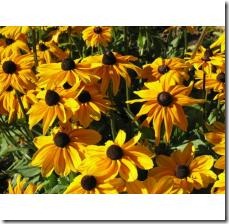The black-eyed Susan (Rudbeckia hirta) is a favorite flower in the garden. A perennial of the daisy family that grows to 3 feet and blooms in summer (typically from July through August), it has a distinctive brown cone and florets in shades of deep orange-gold. It is a non-competitive companion flower for marigolds and makes a pretty backdrop for purple pansies.The black-eyed Susan can thrive in almost any garden and is the choice of many beginning gardeners. It seems to ignore neglect, is drought-tolerant and will thrive in a range of soil conditions.If you have a sunny spot in your garden that doesn’t seem to want to support life, consider planting it with black-eyed Susan. Areas behind or alongside garages or around a mailbox or garbage kiosk are often neglected and will literally bloom with life. Black-eyed Susan self- seeds readily and will fill in quickly. It will transform barren patches in one or two seasons. Best of all, it requires little or no help from you to thrive.
- Difficulty:
- Easy
Instructions
things you’ll need:
- Black-Eyed Susan Flower Seeds
-
Growing Black-Eyed Susan
- Select a spot in the garden that receives at least six hours of sunlight a day. Good light is one of the few important considerations when planting black-eyed Susan.
- Loosen soil and add sand if your soil is primarily clay. Black-eyed Susan doesn’t like wet feet and will not reach its full potential where dense clay is present. The addition of quality compost is also welcome, although it will usually make do with what’s available.
- Place the plant toward the back of the flowerbed. Black-eyed Susan grows to about 3 feet, so keep it behind its shorter neighbors.
- Allow room for the plant to spread out. Keeping it at least a foot from its nearest neighbor is a good strategy.
- Separate plants every three years in order to maintain large flowers and avoid plant stress.
Tips & Warnings
-
The black-eyed Susan is also known as the gloriosa daisy.
-
Although drought tolerant, mulching black-eyed Susan in spring in areas that experience hot, dry summers will result in better growth and more flowers.
-
Mulching in autumn in areas that experience hard freezes will help to protect and strengthen the plant.
-
Black-eyed Susan makes an attractive cut flower that will last up to a week in water.
-
Black-eyed Susan is also available in a vining variety, with flowers in palest yellow to deep mauve.
-
Sometimes black-eyed susan can have problems with powdery mildew. Watch for twisted brown leaves toward the bottom of the plant. If you detect these signs, start a spraying program immediately.


Deprecated: strpos(): Passing null to parameter #1 ($haystack) of type string is deprecated in /home/agriviek8Qv/agriviet.net/public_html/wp-includes/comment-template.php on line 2522